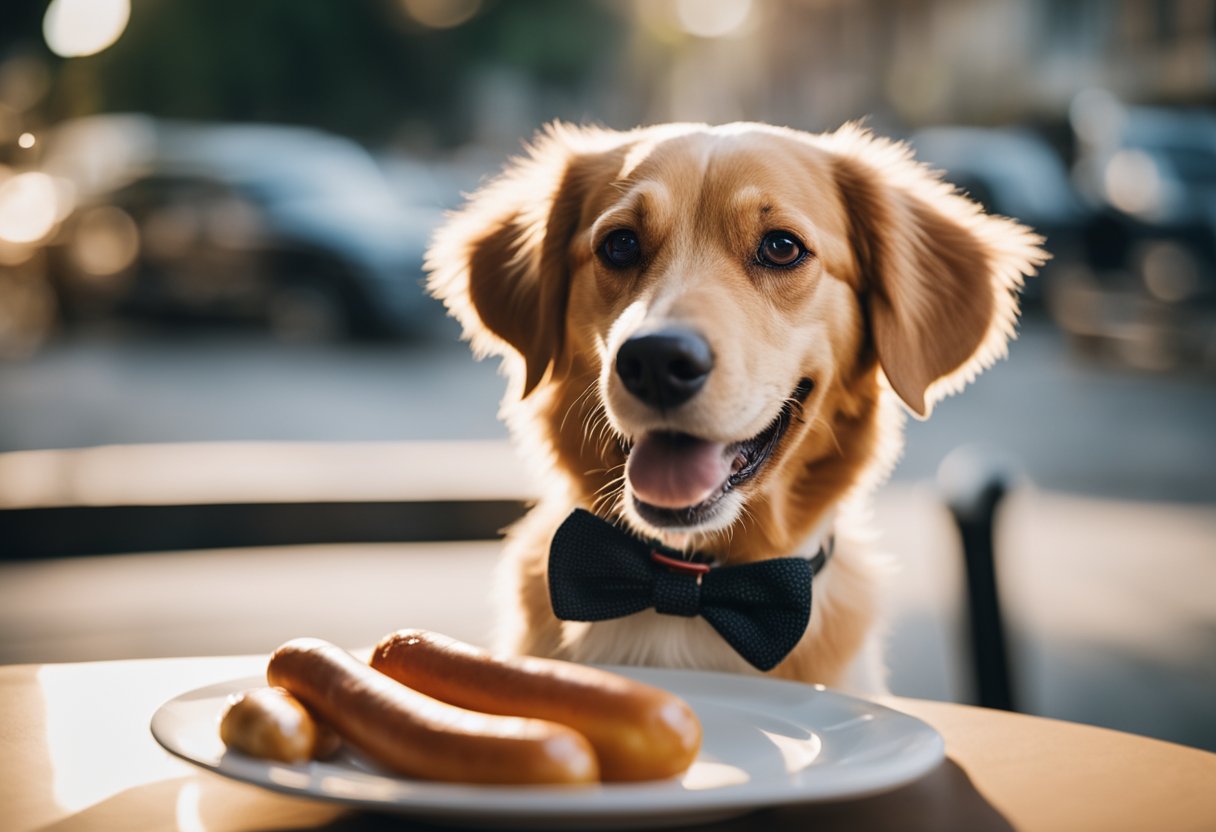Can Dogs Eat Sausage? Understanding the Risks and Benefits
Many dog owners enjoy sharing their meals with their furry friends. You might wonder if it’s safe to let your dog indulge in sausage. While a small piece of sausage may not be harmful, it’s generally best to avoid giving it to your dog regularly.
Sausages can be high in fat, sodium, and other ingredients that are not good for dogs. Most types of sausage can lead to stomach issues or long-term health problems if eaten in excess. Understanding what’s safe for your dog can help you keep them healthy and happy while still enjoying mealtimes together.
Key Takeaways
- Avoid feeding your dog sausages regularly to prevent health issues.
- High-fat and salty foods can upset your dog’s stomach.
- Consider healthier treat alternatives for your furry friend.
Nutritional Considerations for Dogs

When considering feeding sausage to your dog, it’s essential to look at several nutritional factors. These include the protein, fat, additives, and salt content found in sausage. Understanding these components can help you make informed decisions about your dog’s diet.
Protein Content in Sausage for Dogs
Sausage typically contains a good amount of protein. Protein is important for a dog’s growth, muscle development, and overall health. However, not all proteins are equal.
Types of Protein:
- Animal Protein: Sausages made from meats like chicken or beef offer animal-based protein, which is generally more beneficial for dogs.
- Plant Protein: Some sausages may include fillers like soy, which are not as effective for canine nutrition.
Consider your dog’s specific nutritional needs when evaluating sausage’s protein content. A dog that is active may require more protein than a less active one. Just remember to check the sausage label for other ingredients that might not be suitable for your pet.
Fat Content and Health Risks
Sausages are often high in fat, which can pose several health risks for dogs. While some fat is necessary in a dog’s diet, too much can lead to serious health conditions.
- Obesity: Regular consumption of high-fat foods can contribute to obesity. This can lead to further health issues such as diabetes and joint problems.
- Pancreatitis: A sudden high-fat meal can cause pancreatitis, a painful inflammation of the pancreas. This condition can be acute or chronic, requiring veterinary care.
Monitor your dog’s fat intake by checking serving sizes and choosing lower-fat sausage options when possible. Balance is key for maintaining their health.
Additives and Spices in Sausages
Many sausages contain additives and spices that can be harmful to dogs. Common ingredients like garlic, onion, and certain preservatives should be avoided.
- Garlic and Onion: Both are toxic to dogs and can cause gastrointestinal issues and damage to red blood cells.
- Preservatives: Some processed meats have nitrates and nitrites, which might not be ideal for your dog’s health.
Always read the ingredient list carefully before feeding sausage to your pet. Opt for products that are free from harmful additives to ensure your dog stays healthy.
Salt and Sodium Levels
Sausages often contain high levels of salt and sodium, which can be harmful to dogs in large amounts.
- Thirst and Urination: High sodium can lead to excessive thirst and frequent urination.
- Heart Health: Over time, excessive salt can strain your dog’s heart and lead to issues like hypertension.
Limit how often you give sausage as a treat and be mindful of the salt content. Choose low-sodium options whenever possible to protect your dog’s health.
Feeding Practices and Alternatives

When considering sausages for your dog, it’s essential to be aware of portion sizes and healthier options. You want to make safe choices that promote your dog’s well-being while satisfying their cravings.
Appropriate Portion Sizes for Dogs
When feeding sausage to your dog, moderation is key. A small dog may only need a bite or two, while a larger dog can handle a piece the size of a sausage link.
General Portion Guidelines:
- Small Dogs (under 20 lbs): 1/4 to 1/2 of a sausage link.
- Medium Dogs (20-50 lbs): 1/2 to 1 sausage link.
- Large Dogs (over 50 lbs): Up to 1 full link, but watch for any signs of upset stomach.
Always introduce sausage gradually. Monitor your dog’s reaction and adjust portions as needed to prevent any gastrointestinal distress.
Healthier Alternatives to Sausage
If you’re looking for healthier options, there are plenty of delicious alternatives you can offer. Lean meats without additives or spices are great choices. Here are some options:
- Chicken or Turkey: Skinless and boneless for a low-fat treat.
- Beef: Choose lean cuts and cook without added salt or spices.
- Fish: Salmon or white fish can be nutritious and enjoyable.
Additionally, consider veggies like carrots or sweet potatoes, which are healthy and provide fiber. Always ensure any treats align with your dog’s dietary needs.
Homemade Dog-Friendly Sausages
Making your own dog-friendly sausages can be a fun and healthy alternative. You can control the ingredients and avoid harmful additives.
Basic Recipe:
- Ingredients:
- Lean ground meat (chicken, turkey, or beef)
- Oats or brown rice (for texture)
- Egg (for binding)
- Optional: plain pumpkin or spinach
- Instructions:
- Preheat your oven to 350°F.
- Mix all ingredients in a bowl until well combined.
- Shape into small patties or logs and place on a baking sheet.
- Bake for 25-30 minutes until fully cooked.
These homemade treats can be stored in the fridge for a week or frozen for longer.
Resources

When considering whether dogs can eat sausage, it’s essential to gather accurate information. Here are some helpful resources:
- Sausage Ingredients: Learn about harmful ingredients often found in sausages, such as onions and garlic, by checking out this article on what’s bad for dogs.
- Signs of Pancreatitis: Understand what symptoms to look for if your dog eats too much fat. You can find more details on pancreatitis in dogs.
- Healthy Alternatives: Explore safer treat options for your dog in this detailed guide about safe dog treats.
- Expert Veterinary Advice: A vet-approved guide outlines what cooked sausage can do to your dog’s health. Discover that information at vet-approved sausage advice.
- General Nutrition Tips: For comprehensive insights on your dog’s diet, visit dog nutrition basics.
Using these resources can help you make informed decisions about your dog’s diet and ensure their health and well-being. Always consult with your vet if you’re unsure.
Frequently Asked Questions

You may have questions about feeding sausages to your dog. It’s important to understand the safety and health aspects. Here are some common inquiries.
At what age is it safe for dogs to start eating sausages?
Dogs can start eating small amounts of sausages at around one year old. Younger puppies have sensitive stomachs and should stick to their normal diet.
Is it okay for dogs to have cooked sausages?
Yes, cooked sausages can be safe for dogs. Ensure they are plain, without spices or sauces that may be harmful.
Are pork sausages harmful to dogs?
Pork sausages can be risky for dogs. They often contain high-fat content, which can lead to health issues like pancreatitis.
Can consuming sausage rolls pose a risk to a dog’s health?
Yes, sausage rolls can pose risks. They usually contain ingredients like dough and seasonings that are not safe for dogs.
Is it safe for dogs to eat chicken sausages?
Chicken sausages can be safer compared to others. Always check for additives and ensure they are cooked without harmful seasonings.
What is the recommended quantity of sausages a dog can have?
A small piece of sausage once in a while is okay. Generally, it’s best not to exceed one or two bites to avoid health problems.

